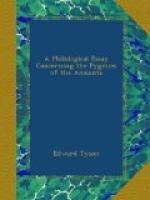equivalent to abakwetu, applied to the Amatongo,
and among the Highlands they are called the ‘good
people’ and ‘the folk.’ They
are also said to ‘live underground,’ and
are therefore Abapansi or subterranean. They
are also, like the Abapansi, called ancestors.
Thus the Red Book of Clanranald is said not to have
been dug up, but to have been found on the moss; it
seemed as if the ancestors sent it.” There
are other points which make in the same direction.
The soul is supposed by various races to be a little
man, an idea which at once links the manes of the
departed with Pigmy people. Thus Dr. Nansen tells
us that amongst the Eskimo a man has many souls.
The largest dwell in the larynx and in the left side,
and are tiny men about the size of a sparrow.
The other souls dwell in other parts of the body,
and are the size of a finger-joint.[C] And the Macusi
Indians[D] believe that although the body will decay,
“the man in our eyes” will not die, but
wander about; an idea which is met with even in Europe,
and which perhaps gives us a clue to the conception
of smallness in size of the shades of the dead.
Again, the belief that the soul lives near the resting-place
of its body is widespread, and at least comparable
with, if not equivalent to, the idea that the little
people of Scotland, Ireland, Brittany, and India live
in the sepulchral mounds or cromlechs of those countries.
Closely connected with this is the idea of the underground
world, peopled by the souls of the departed like the
Abapansi, the widespread nature of which idea is shown
by Dr. Tylor. “To take one example, in
which the more limited idea seems to have preceded
the more extensive, the Finns,[E] who feared the ghost
of the departed as unkind, harmful beings, fancied
them dwelling with their bodies in the grave, or else,
with what Castren thinks a later philosophy, assigned
them their dwelling in the subterranean Tuonela.
Tuonela was like this upper earth; the sun shone there,
there was no lack of land and water, wood and field,
tilth and meadow; there were bears and wolves, snakes
and pike, but all things were of a hurtful, dismal
kind; the woods dark and swarming with wild beasts,
the water black, the cornfields bearing seed of snake’s
teeth; and there stern, pitiless old Tuoni, and his
grim wife and son, with the hooked fingers with iron
points, kept watch and ward over the dead lest they
should escape.”
[Footnote A: Primitive Culture, i. 388.]
[Footnote B: Religious System of the Amazulu, p. 226.]
[Footnote C: Nansen, ut supra, p. 227.]
[Footnote D: Tylor, ut supra, i. 431.]
[Footnote E: Tylor, ut supra, ii. 80.]




